I am so glad there are others who are also not wholly smitten by the ‘leave no trace’ extremism. In any number of unlikely places over the years I have come across ingeniously constructed huts and fishing/hunting camps sprinkled (without eg Government or Parks Vic’s blessing, or knowledge) throughout our wonderful Victorian mountains. 10,000 more would not go amiss!
Small discreetly placed backcountry huts which can shelter a handful of people in difficult conditions (and so save lives) connected by safe known routes are an enhancement to ‘wilderness values’ and should be encouraged rather than banned.
I am not talking about the (official) huts that ‘everyone’ knows about – and which even appear on maps – like the one at Black Snake Creek on the Wonnangatta River which is nearly a hundred years old now (constructed by the last resident of that 1930’s gold mining town, Harry Gee).
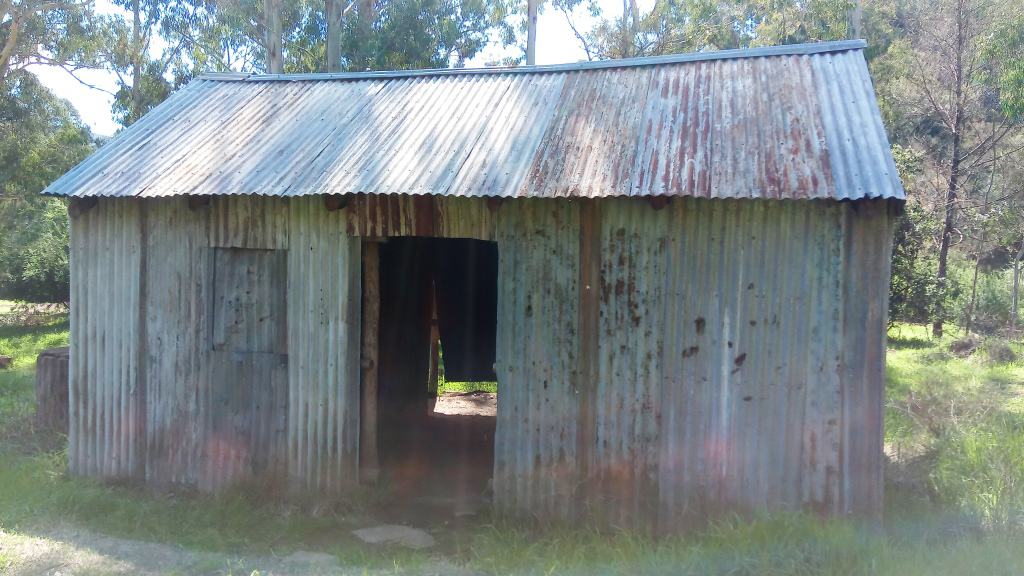
People have lovingly restored (this) Harry’s hut but without the lean-to at the back for his horse, firewood etc. They have had to delete the chimney recently because of human vermin who ‘threatened’ to burn it down. We used to camp right next to this hut between Xmas and New Year when the children were young and spend our days canoeing that lovely river from Kingwill Bridge down to the delightful Scorpion Creek Track (now alas closed like so many others by our ‘masters’ – you can enter/exit the river instead at Hut Creek). We always had the area to ourselves back then (but no longer! A toilet has been built there. Always seems to be a lure.)
He had a huge loquat tree behind the hut – the largest I have ever seen, and in front of the hut on this side (and overshadowing it) a vast walnut tree (others were scattered around) which was crowded with Major Mitchell and Gang Gang cockatoos raining tannin soaked half-chewed walnuts down on our camp. The kids used to splash in a pool made with a wall of river stones in the creek just behind the hut with the black snakes! Ah, those days will not come again.
The huts I am speaking of were constructed with great effort and skill away from vehicular access, and usually well camouflaged so that they are not readily found by aerial searches. If a hut is only around 10′ x 10′ (or less) – adequate for comfy shelter for (at least) four people on a winter’s night, and has been blotch-painted, it is extremely hard to find on Google Earth – even when you know exactly where it is.
I checked this against the lovely ‘Morning Glory Hotel’ (which is not even painted) near the Macalister River. I did find it after very careful searching, but there are lots of others I cannot find even though I know exactly where they are. Some alas, are in need of serious repair today, the ‘Sambar Lodge’ in Dry Creek or Arthur Meyer’s hut in Ross Creek for example, though they have provided succour to many a weary hunter/hiker/fisher over long decades. Some like Whitelaw’s Hut, Marthavale Hut and Fiddler’s Green Hut etc have been destroyed by public servants or vandals – there is little difference anyway.
I am once again just back from a small ‘adventure’ with my two tiny dogs in pursuit of one-such ‘forgotten’ hut. This hut is in a remote high country valley. It is an arduous trek of at least a day each way to find it.
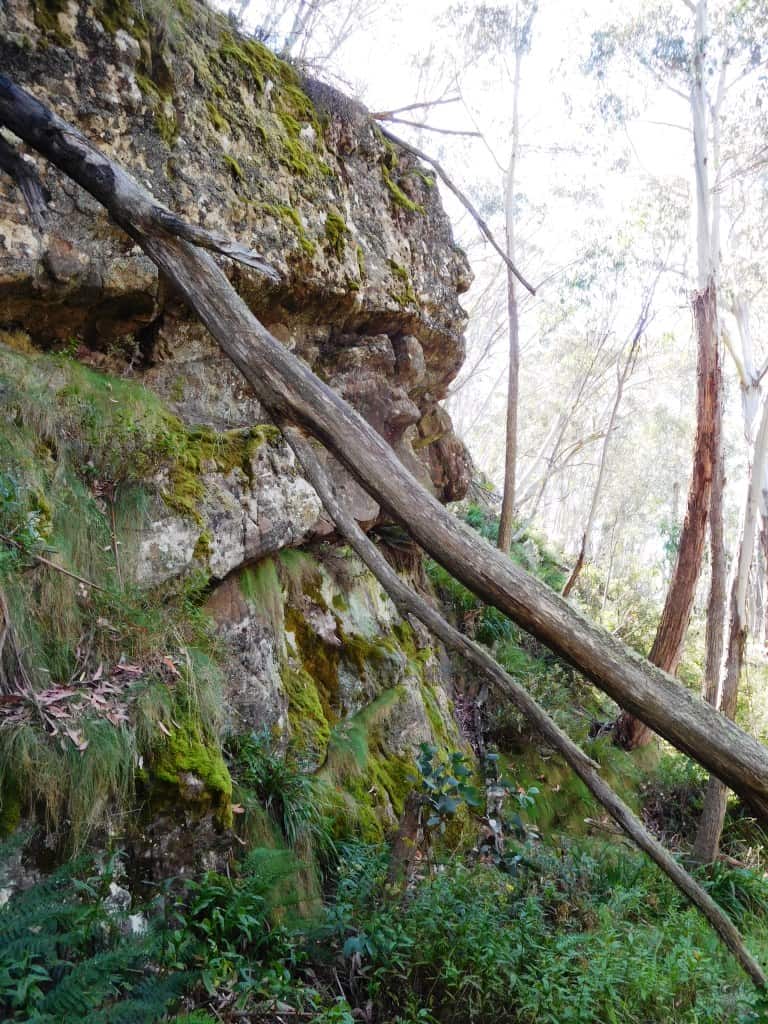
Past some stunning scenery though, I have to say. The ground really drops off the tops there doesn’t it, but above there is a vast expanse of beautiful plateau with substantial grassy clearings.
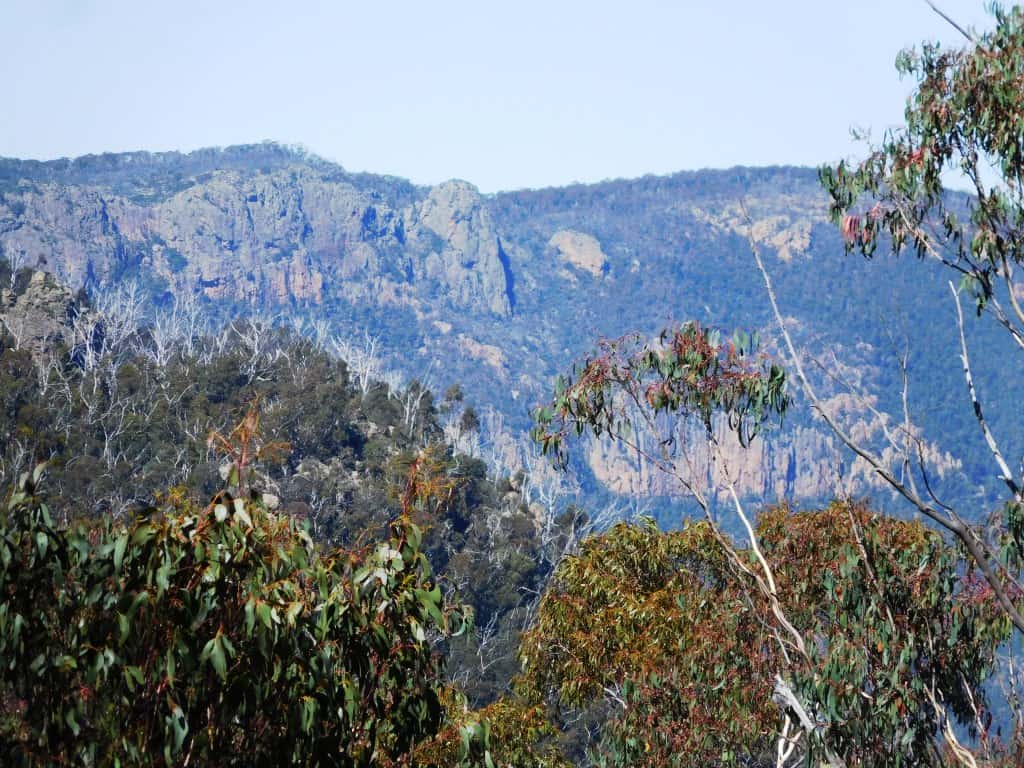
The ‘Man from Snowy River’ never raced down that slope! Camera refused to focus on it, sorry. Sometimes the hills are so steep my eyes won’t focus on them either!
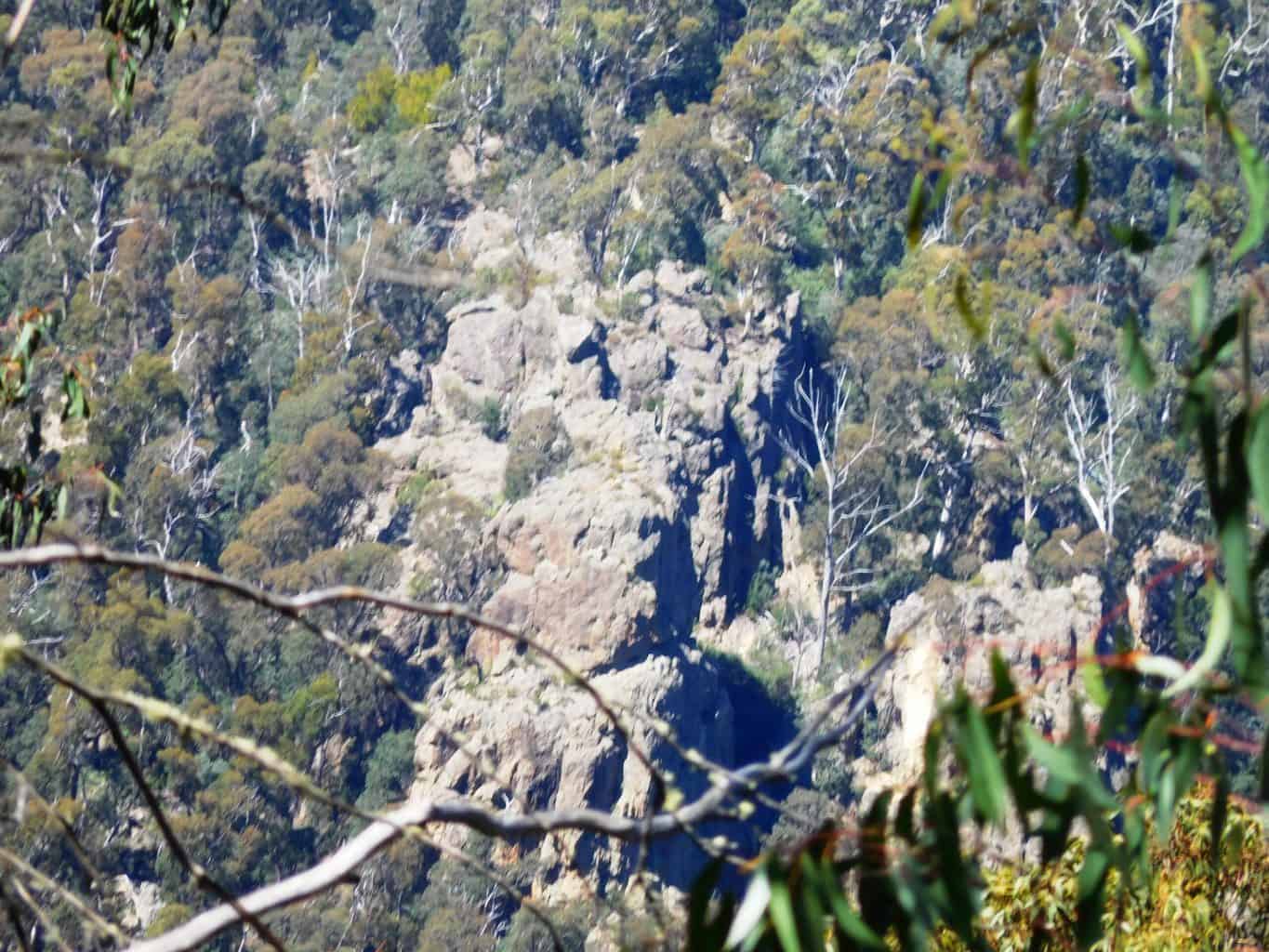
Though there are some quiet serene, almost park-like spots along the way too. A sambar bedding area down there unless I miss my guess.
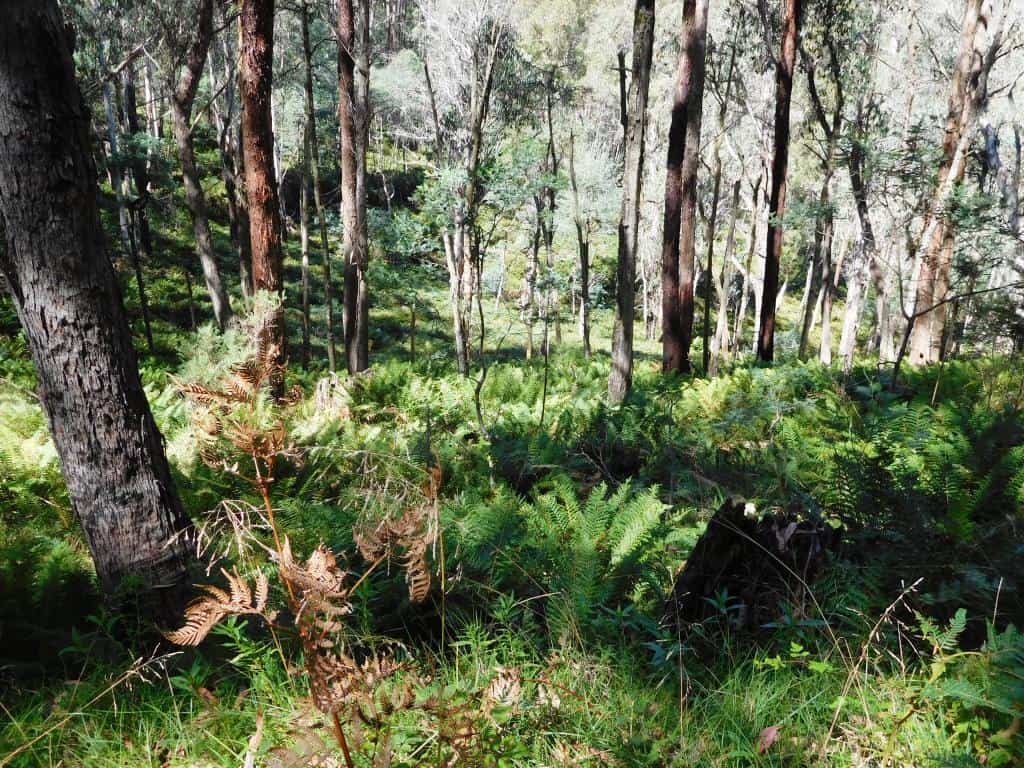
Like this one where we stopped for lunch. ‘More lunch’ Spot says.
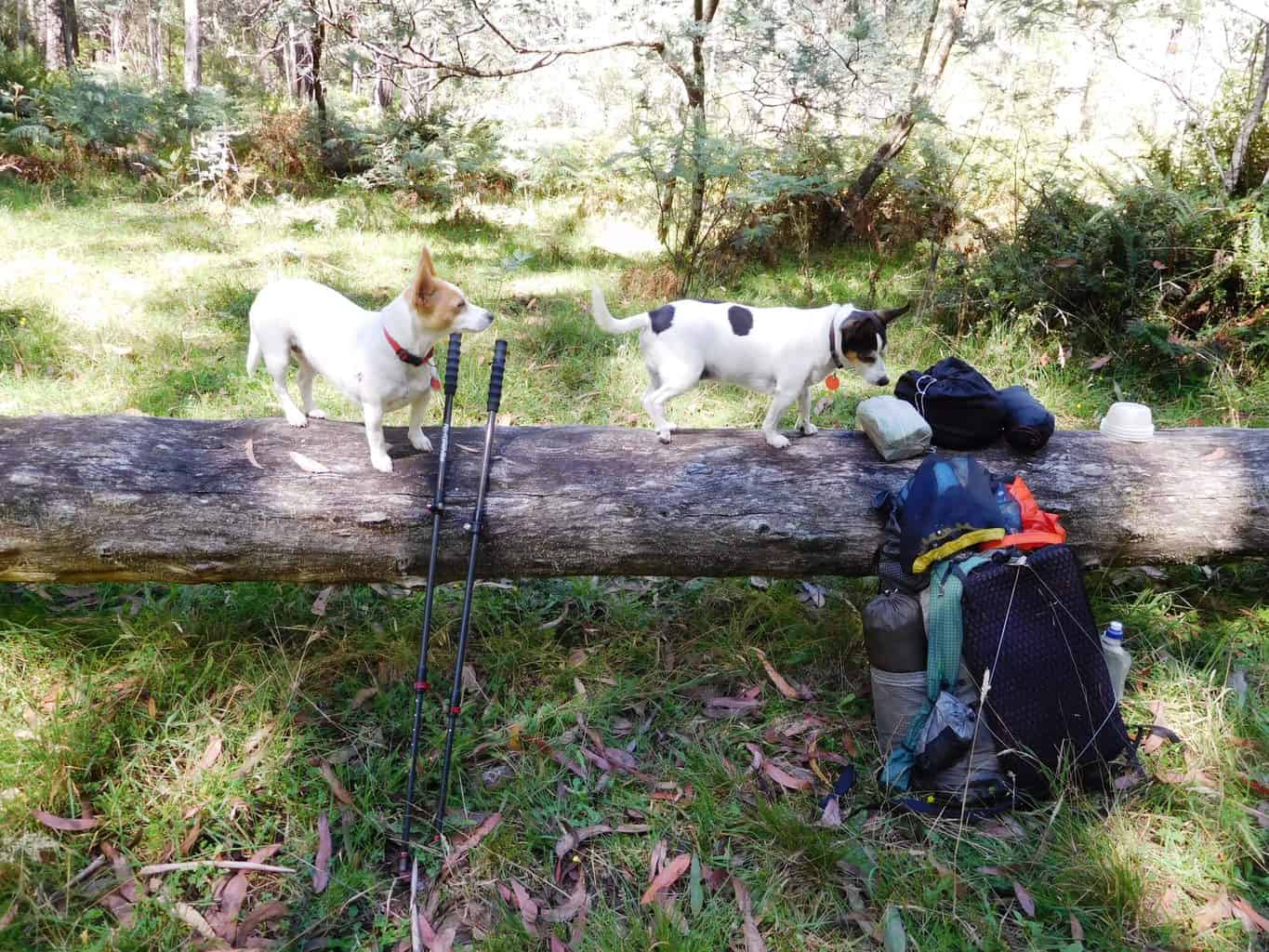
On the first night I camped on a small grassy flat by a crystal-clear stream. Spot is still abed. He has a sore leg. Arthritis I think. We all get old unfortunately. I am beginning treatment. He wants to ‘soldier on’ though as I do too. Note how you can hang your hat etc to dry on a tent pole made from bush sticks something you can’t do with ‘store bought’ tent poles – and you don’t have to carry them. See Ultralight Tent Poles.
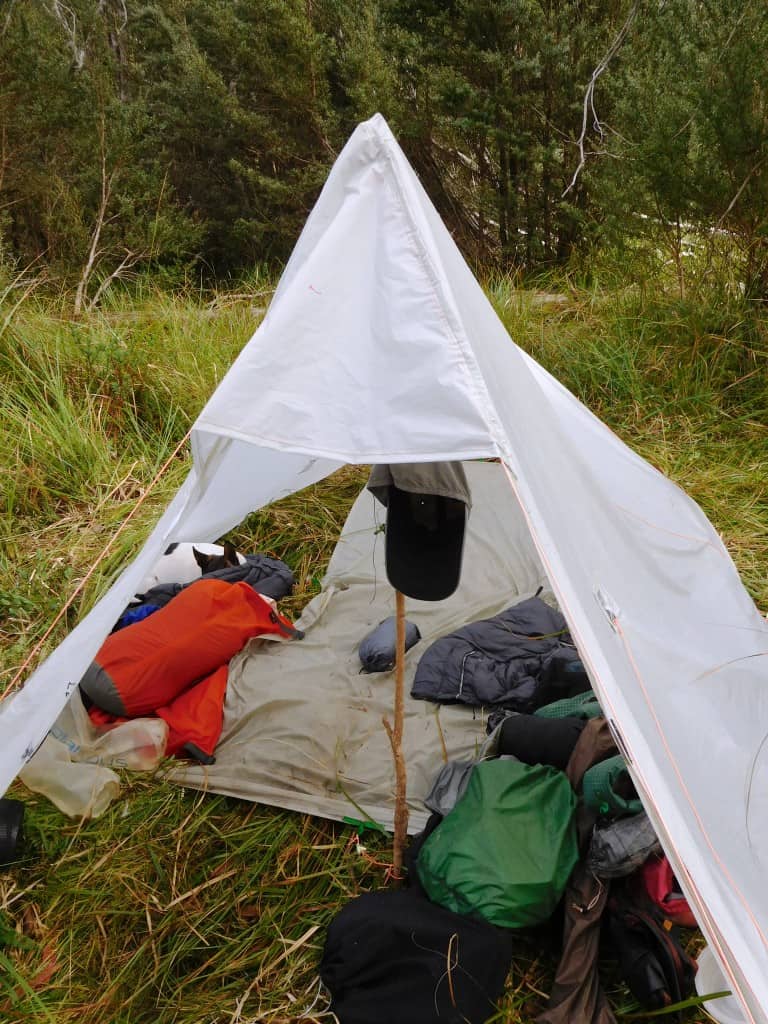
This was my first view in the morning out the door of my Grey Flyer tent. Maybe now you can see why I prefer an open tent? Actually the view was upside-down to this but I know you would have chided me if I hadn’t inverted it!
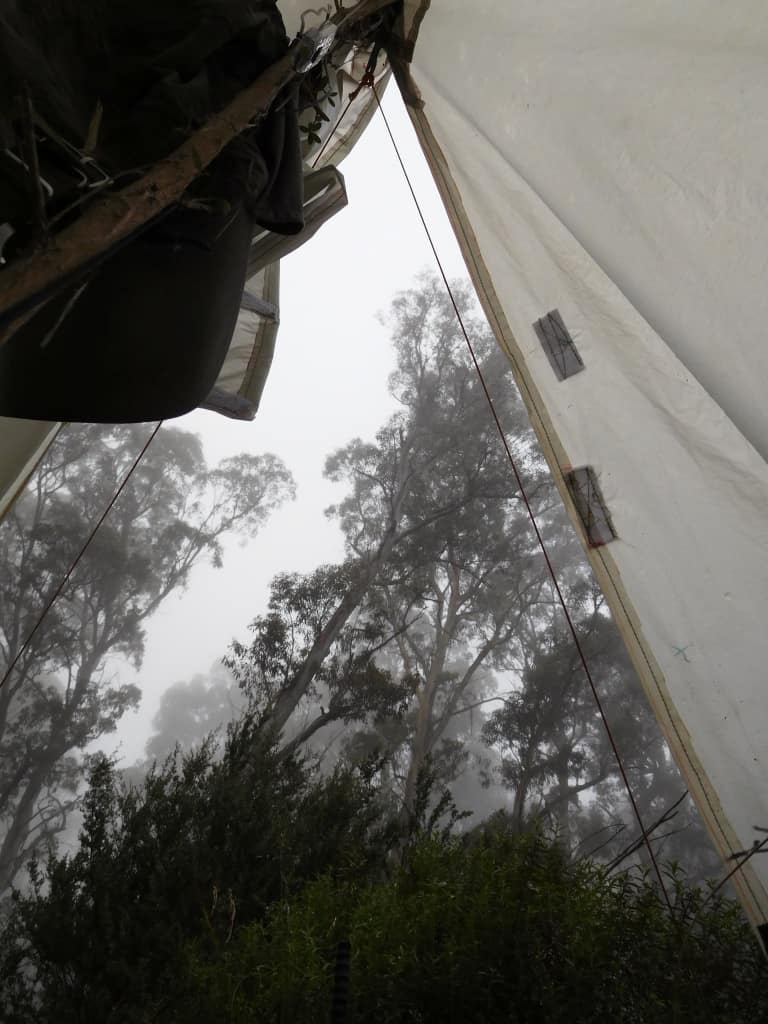
Mostly the going along the creek was hideously thick (after last autumn’s – and previous bushfires), but every now and then there was a beautiful glade like this. A much better spot to have camped if I had found it earlier.
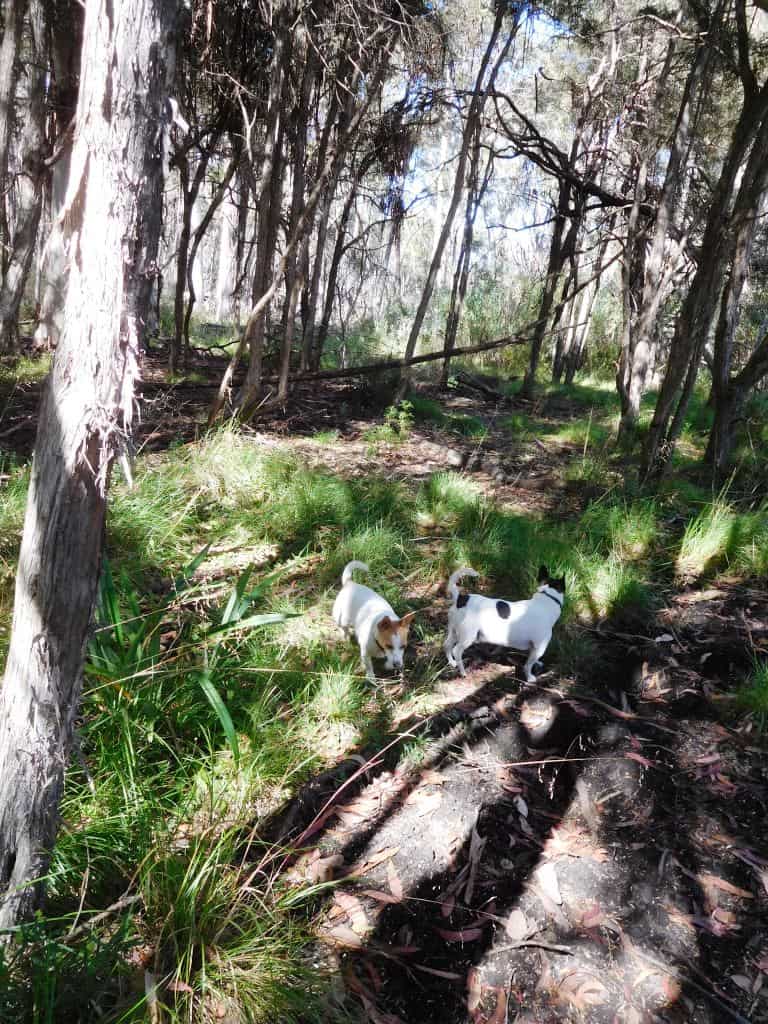
And just then I noticed the hut on the opposite bank of the creek, not quite where I imagined it would be, but not far away either. Hard to spot even when I was looking for it! A simple skillion construction, about 9′ x 9′. The (window) awning lifts up to let in some light and air if needed – an excellent feature.
This hut is constructed (almost) entirely of steel including the sturdy framing, a good idea. Quite some work needed to lug it all into this place. Well done guys! I think some of that wattle regrowth needs to be cleared away myself – but it’s not my hut.
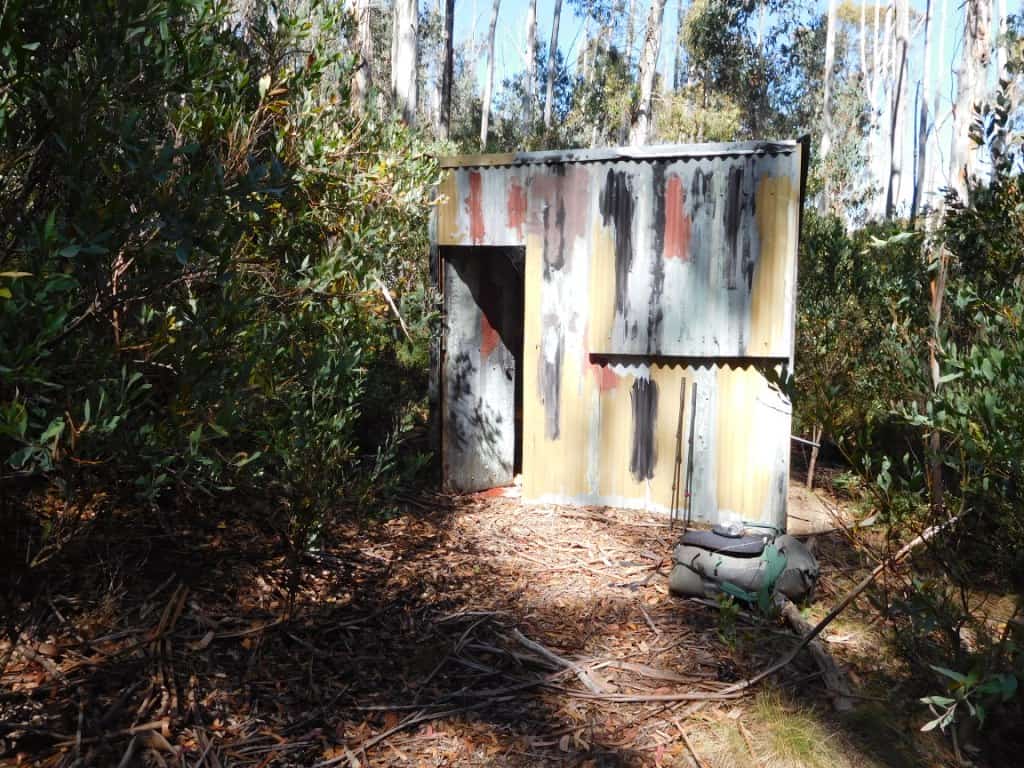
It has a 200 litre drum as a water supply. I think the tank-stand is not such a good idea (It will burn). It should be replaced by steel as well.
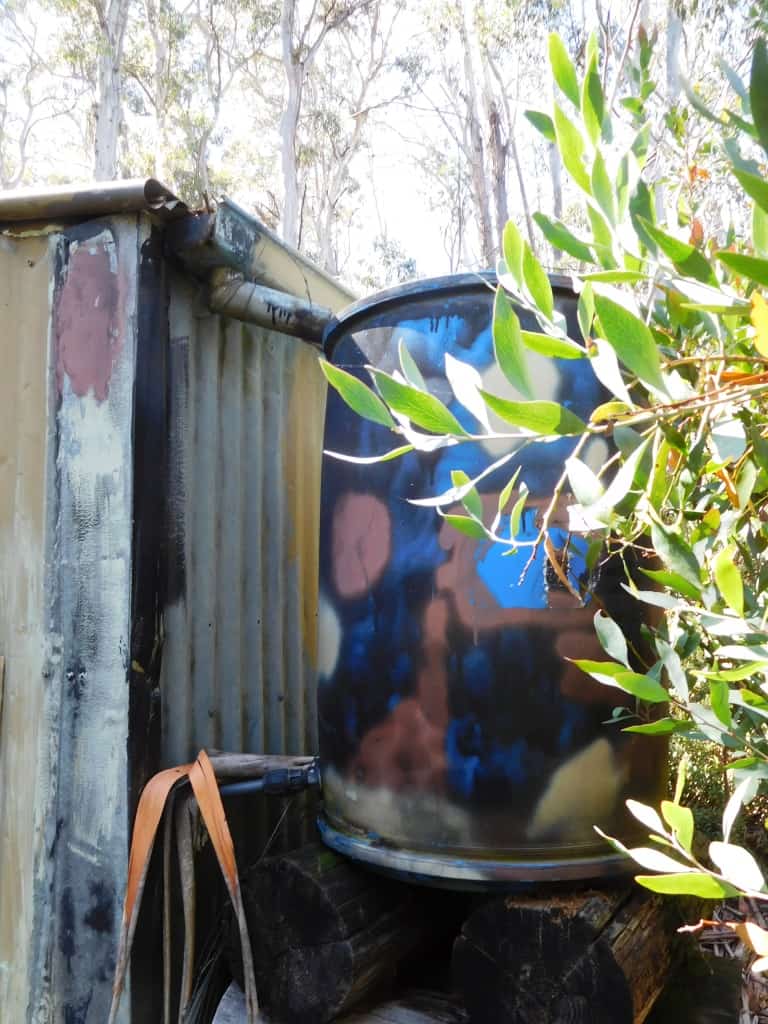
Four bunks with foam mattresses. I think plywood and inflatables would be preferable as open cell foam gets very damp/cold in winter – and the rats love it! Still four bunks and four chairs. You can see what can be done with a small space. Fold up bunks would have created more open space. The two upper bunks could fold down to make (seat) backs for lower ones. Even more space would be available if the bunks occupied a corner and the doorway was in the middle of the entry wall. Such a small rearrangement would have created room for a small (twig) pot-belly stove. Notice these guys even have a shower though!
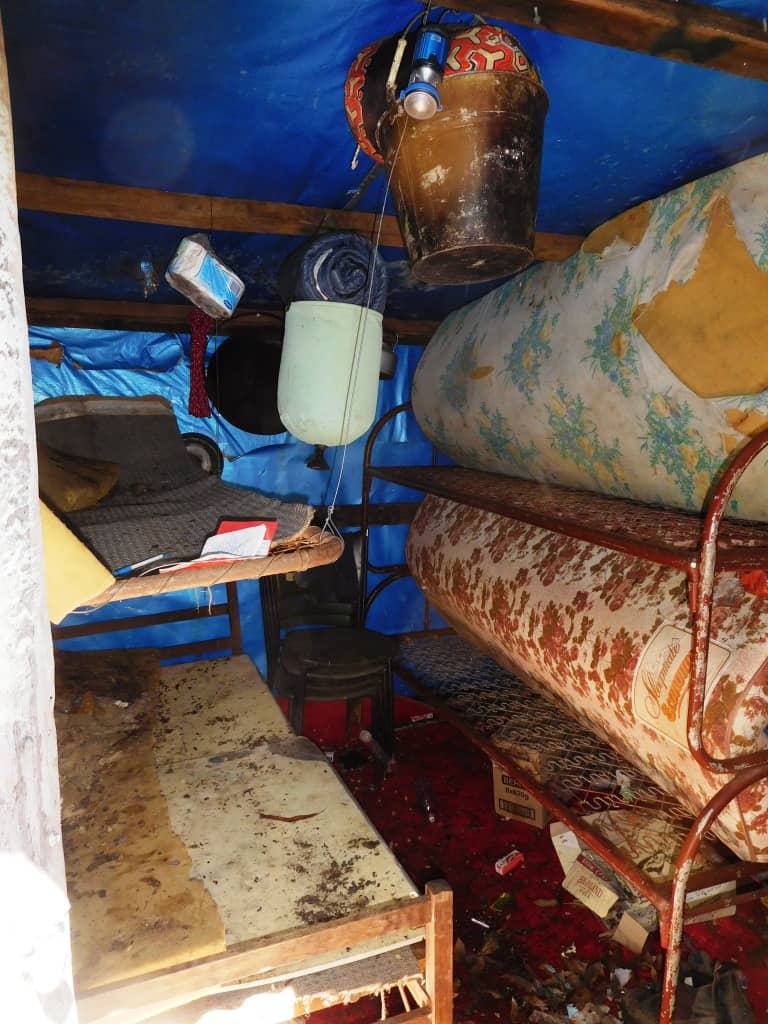
Kitchen facilities and a vermin-proof cupboard. They have been finding some antlers you will notice.
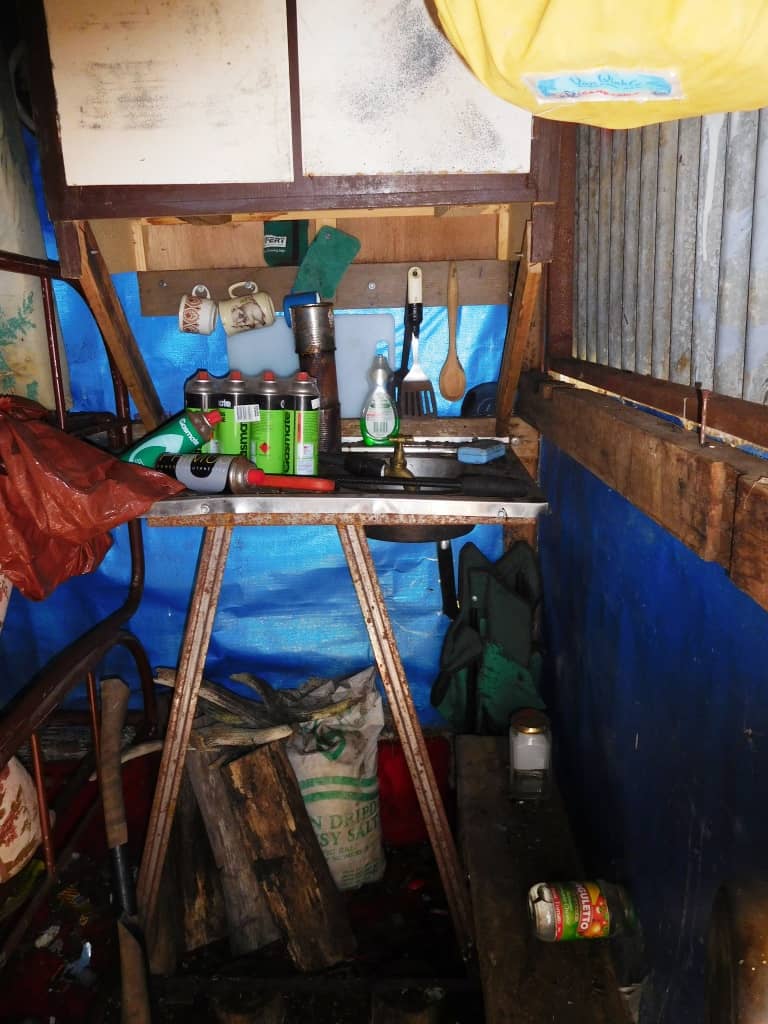
There is a log-book (which I added an entry to) showing that it has about two parties of approx two visitors per year, who by and large take a couple of deer each over a 2-3 day trip. So, not much chance you will have competition if you happen upon it.
‘Constructed by deer hunter’s for deer hunter’s’ the sign says. And good luck to them! May ‘they’ construct many more. It is a pity we can’t share our knowledge of where they are – but that is the world we live in, alas! A world which has too many rules and too much government – a pity we could not make a living by exporting them. We would be able to live on the proceeds for centuries! No, I am not telling you where this hut is – but there are many others. You should get out more! Away from tracks and people! Perhaps if you did not have a 4WD it would be better for you?
Strangely I lost my (progressive) glasses walking out along the overgrown track. I had a spare pair in my pack which I immediately put on but though I spent nearly two hours looking for the lost ones I could not find them even though I (surely) could not have walked 20 metres before I noticed they were missing. I can only think they flicked away as I pushed through some thick vegetation and were not in the line of my trail but off to the side or up in the air caught in a tree somewhere. Mysterious.
My overnight camp on the way out after doing a little more exploring. There is a good spring nearby.
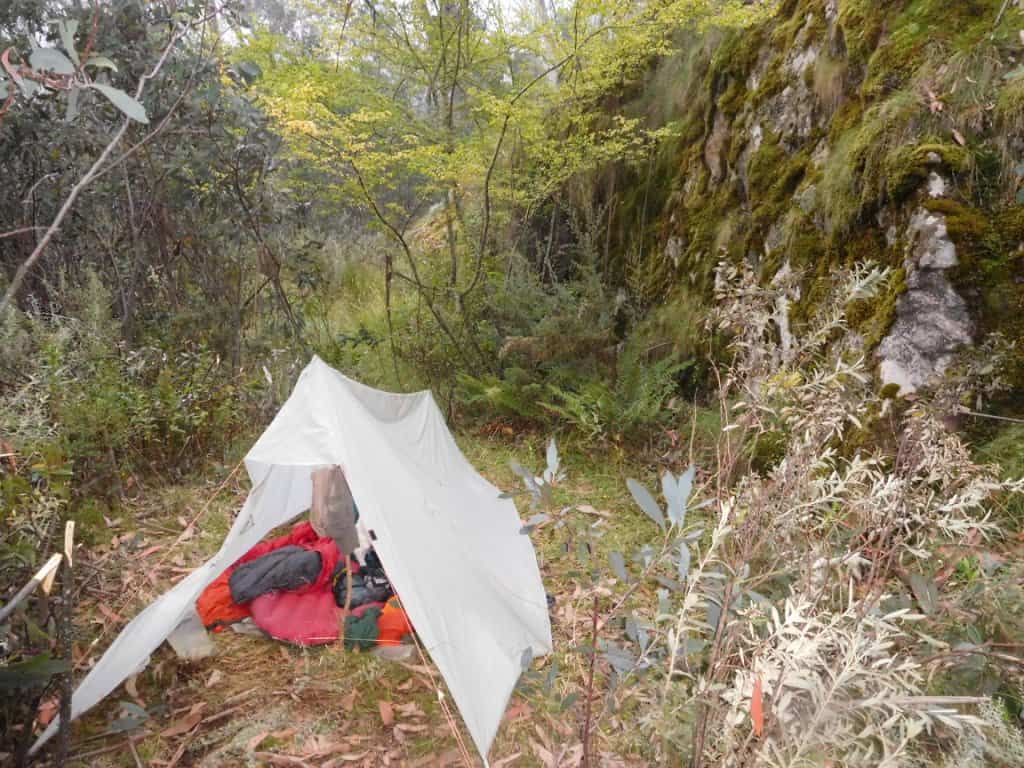
And once again the view of that morning mist.
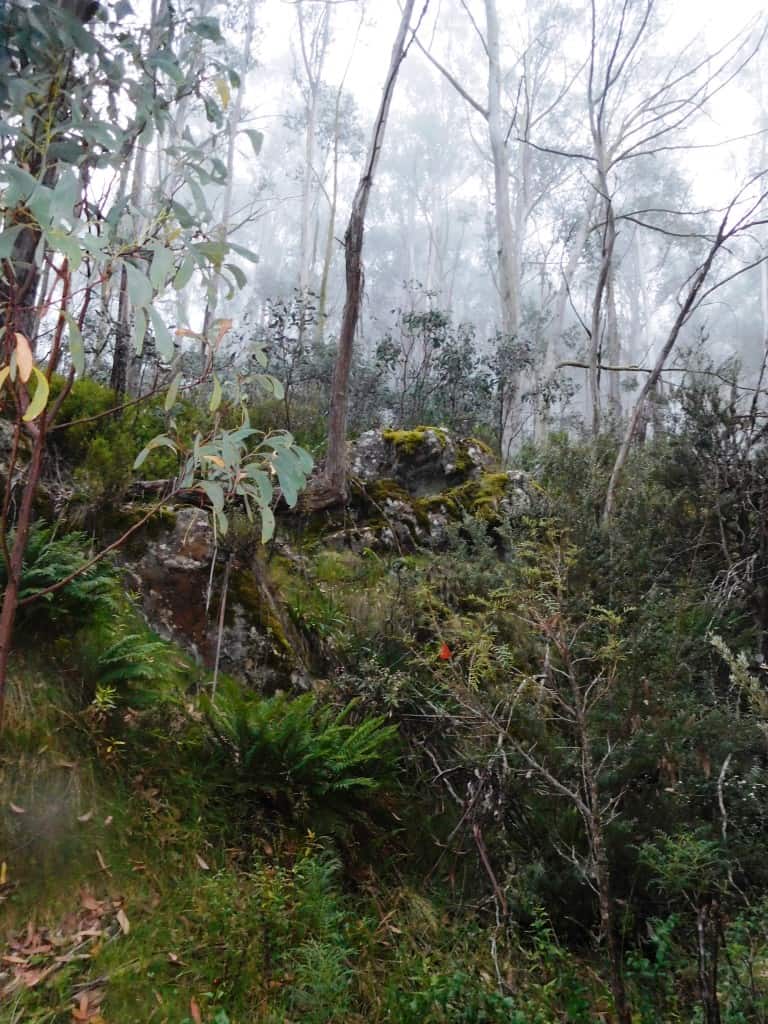
Just a look around. You do have to love the High Country, don’t you?
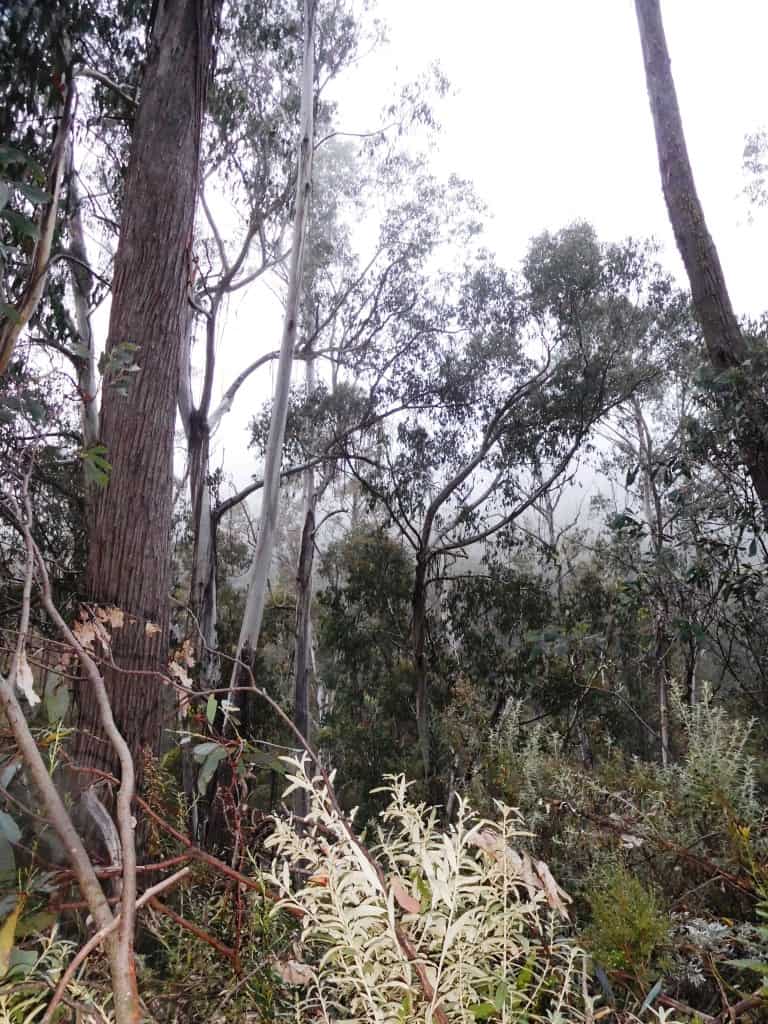
Just magnificent. I could almost wake up to this every morning!
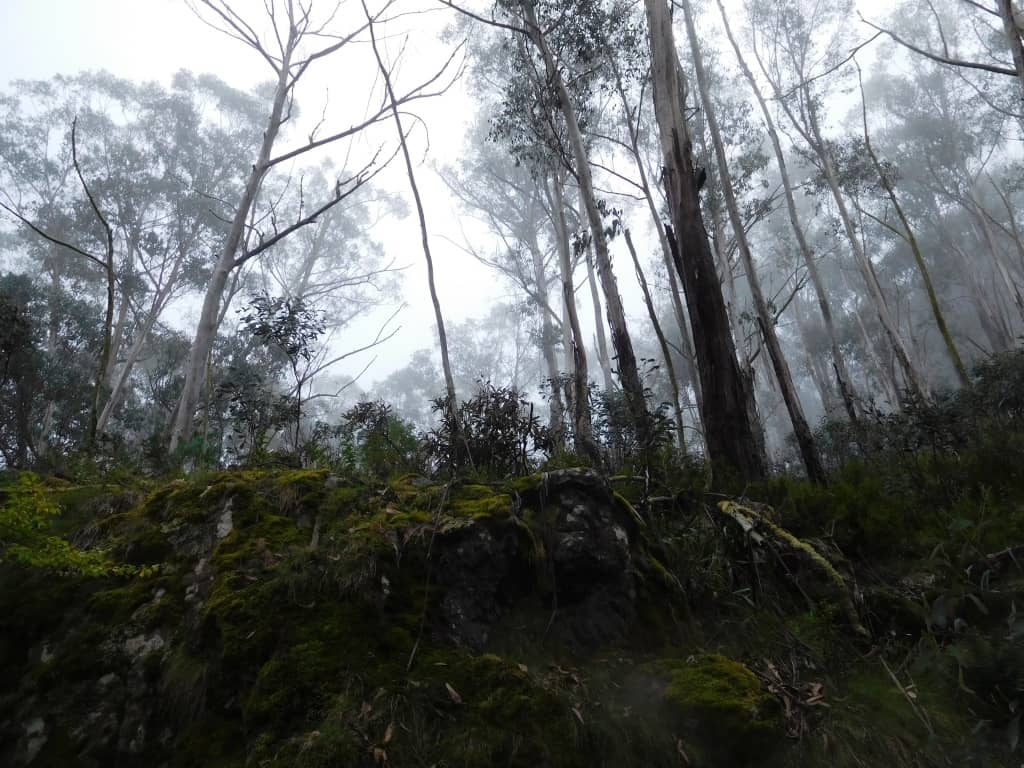
At every season of the year there is edible fruit of some sort in the mountains. These are just two of dozens/hundreds I encountered over 2-3 days. No wonder there are so many parrots and possums! Of course you should also realise that deer love ‘mast’ (ie fruit and nuts). They will travel many miles to get it – as orchardists are only too aware!
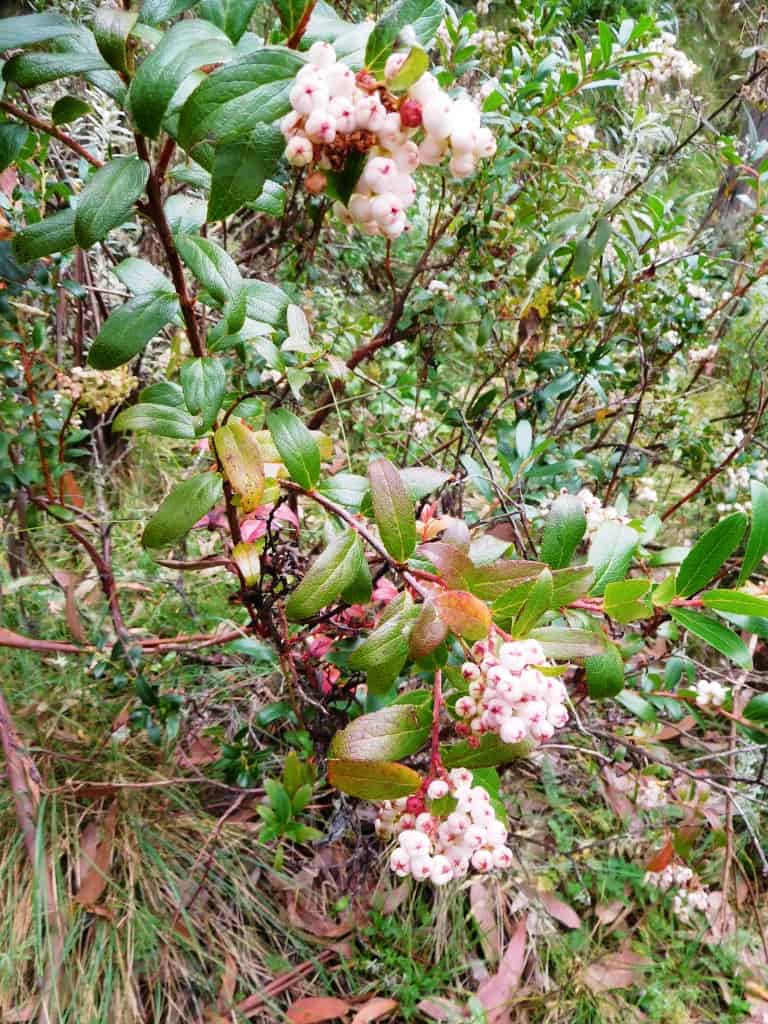
This coprosma is a favourite – as you can see! It is also edible to people. Early settlers prized it as a dessert.
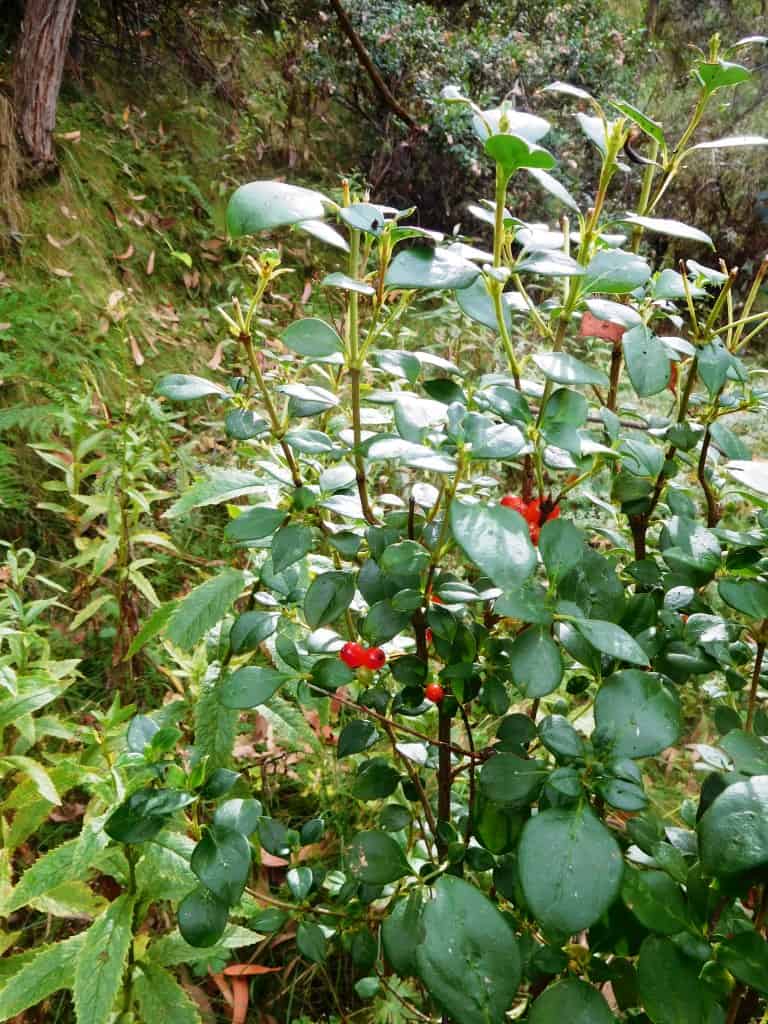
The bush was full of wild flowers as it also always is. That is one reason why there are so many insects and so many insectivorous birds. And so many wild bee species. Here are some of them for your enjoyment.
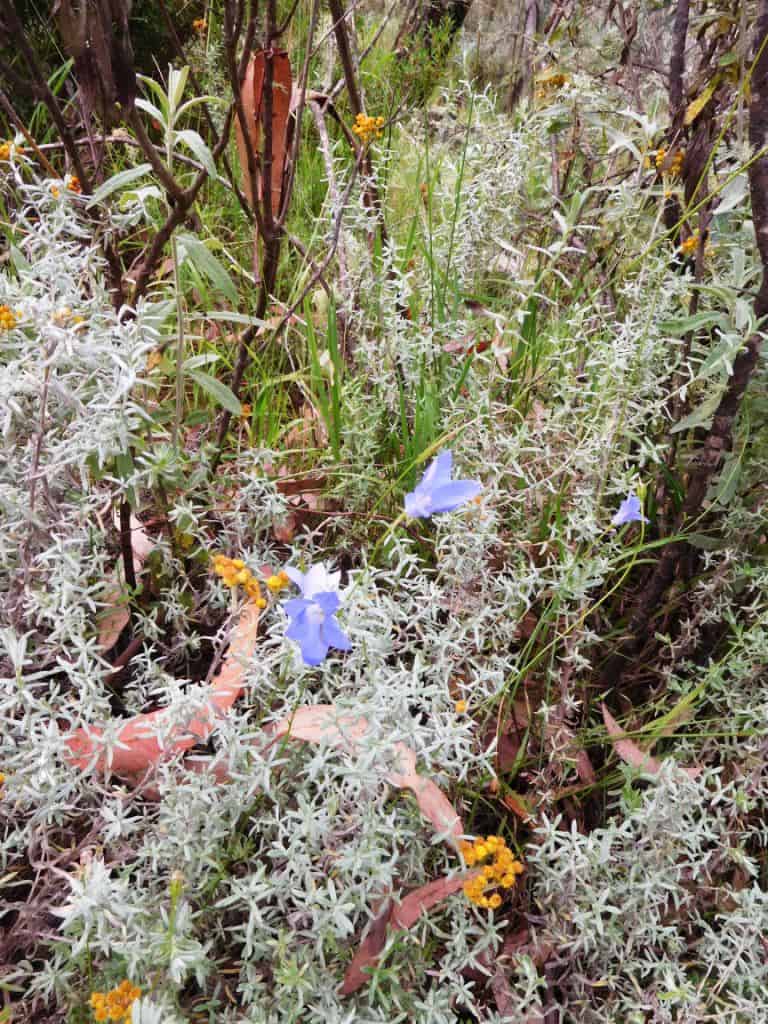
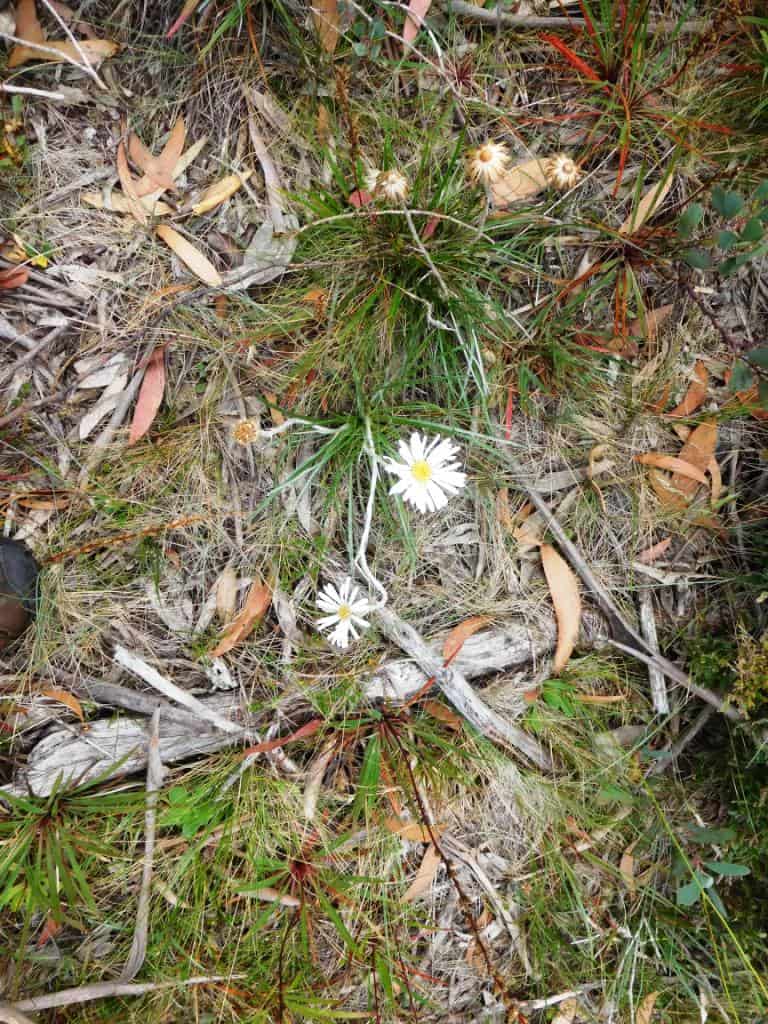
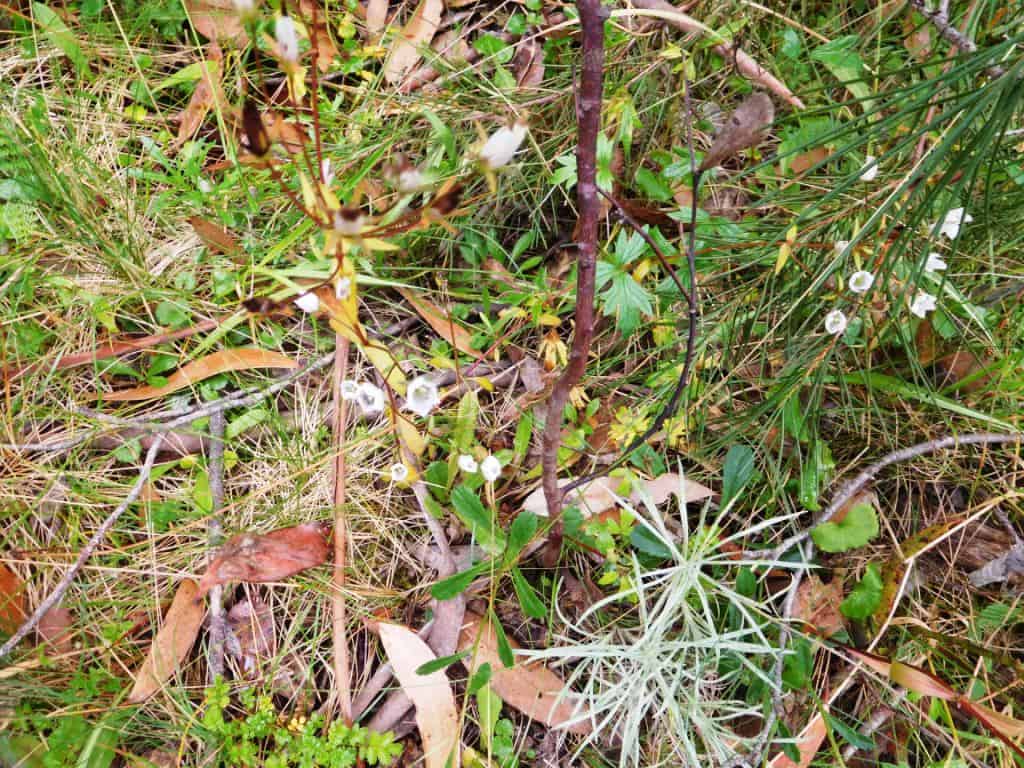
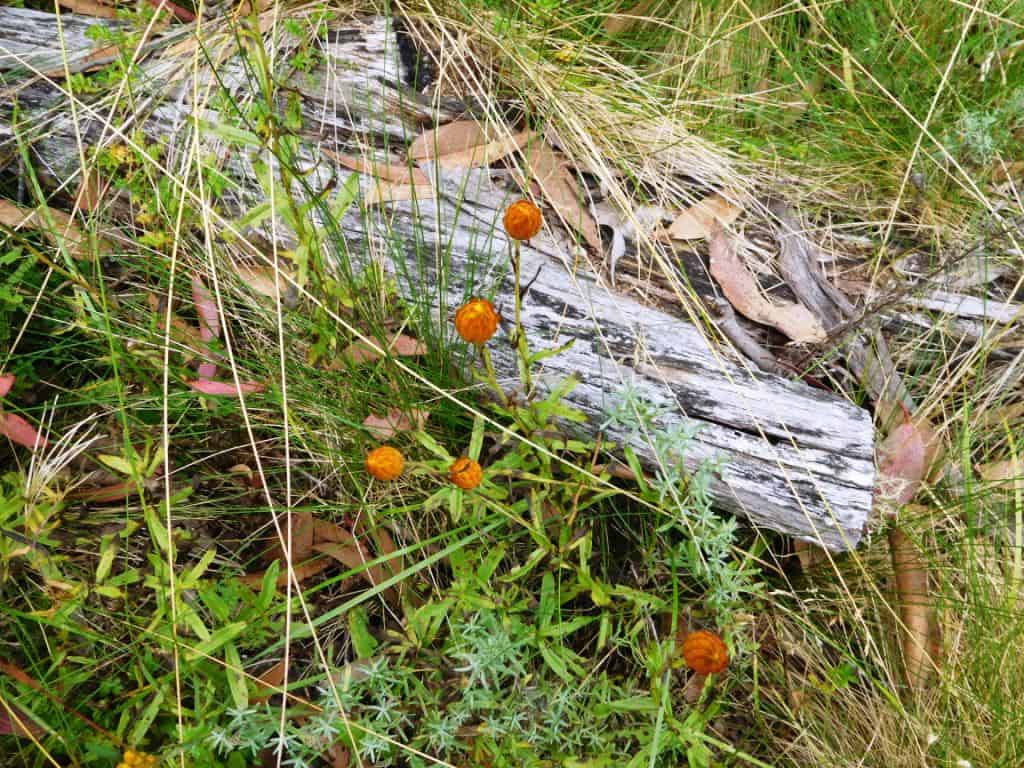
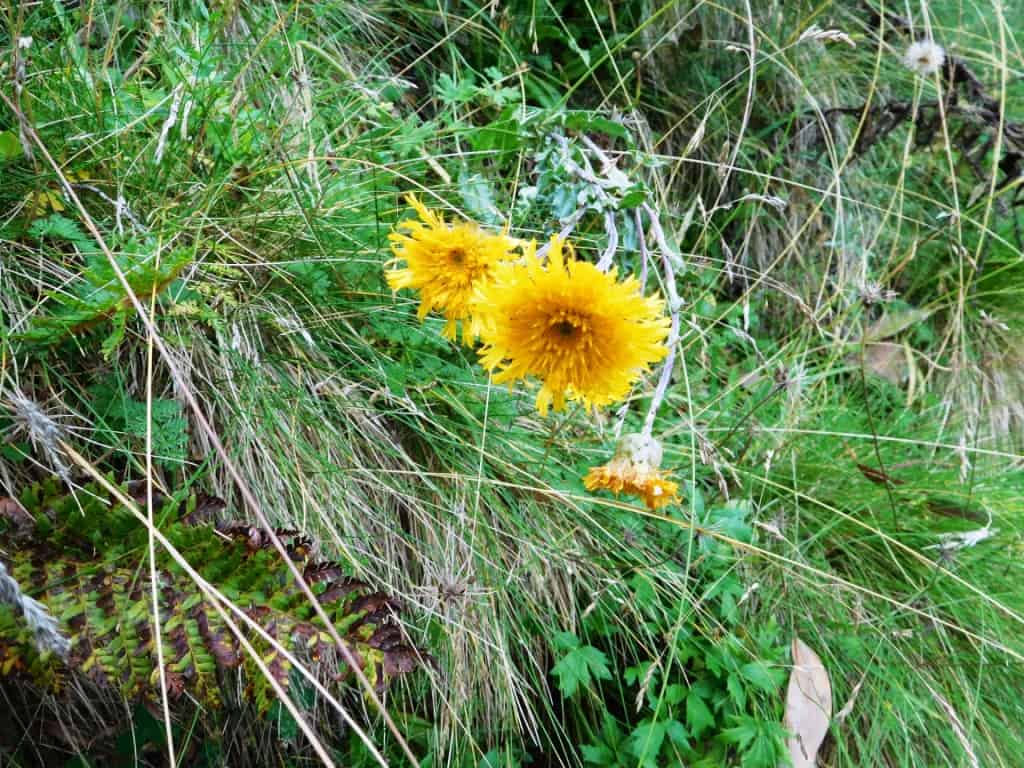
These guys (murnong) which look like dandelions actually have a large edible root and were an important food source. Kerr saw women collecting large baskets of them and growing fat on them on the Western Plains near Echuca.
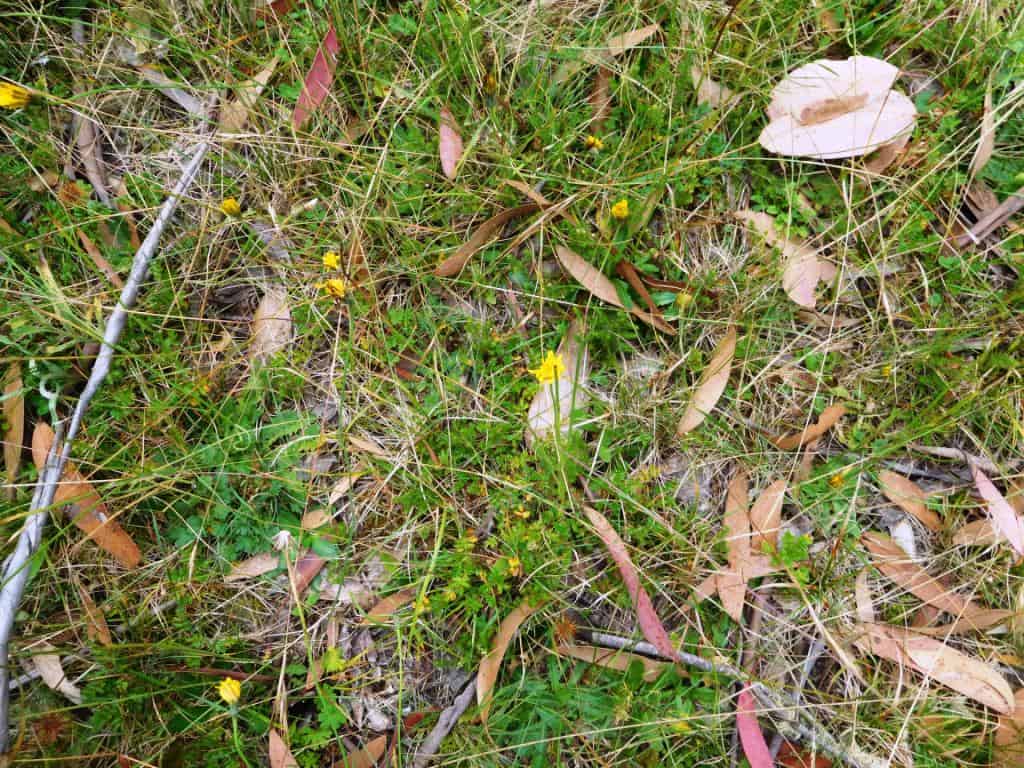
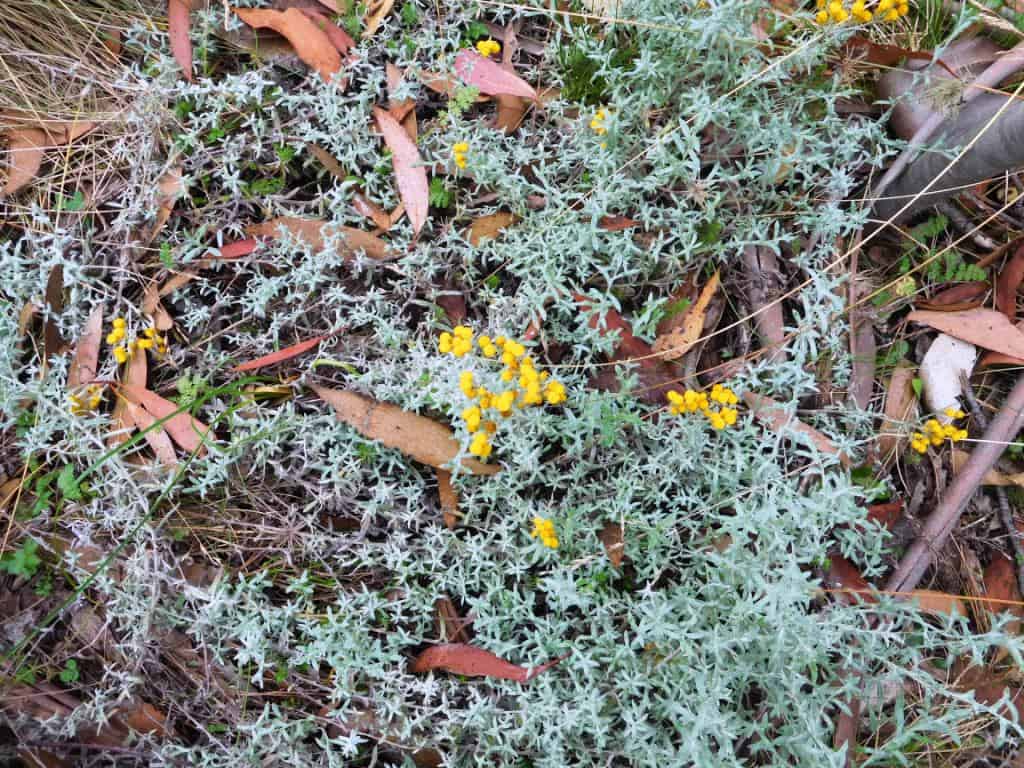
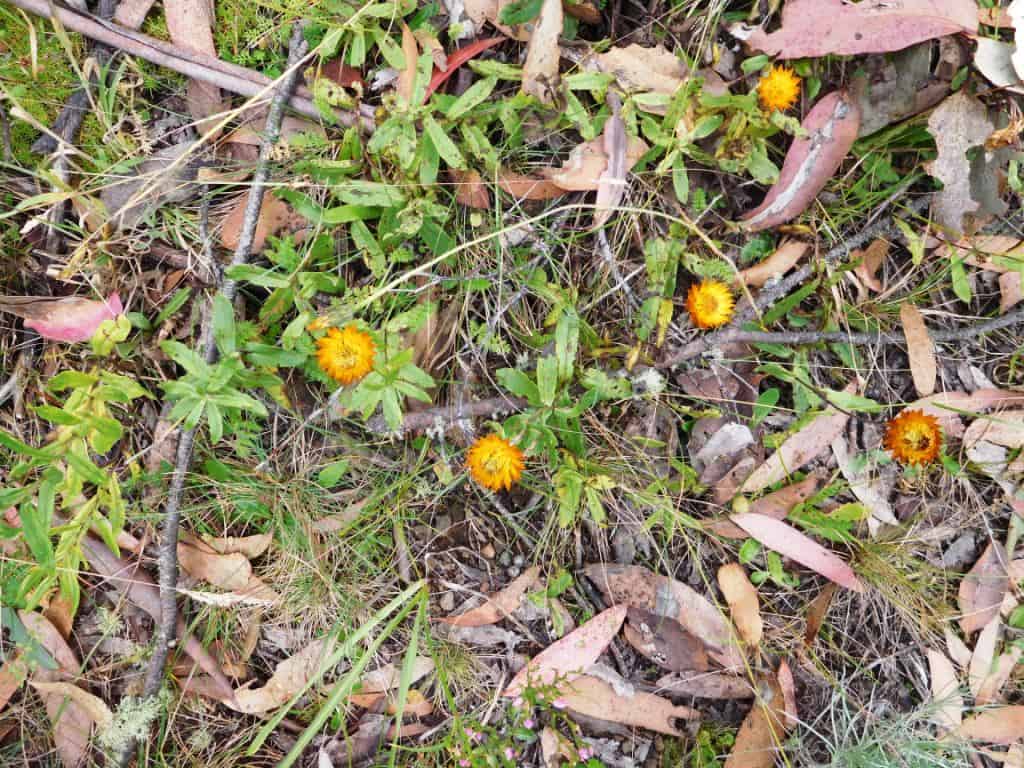
You would think someone would have wanted to eat these fellows, wouldn’t you?
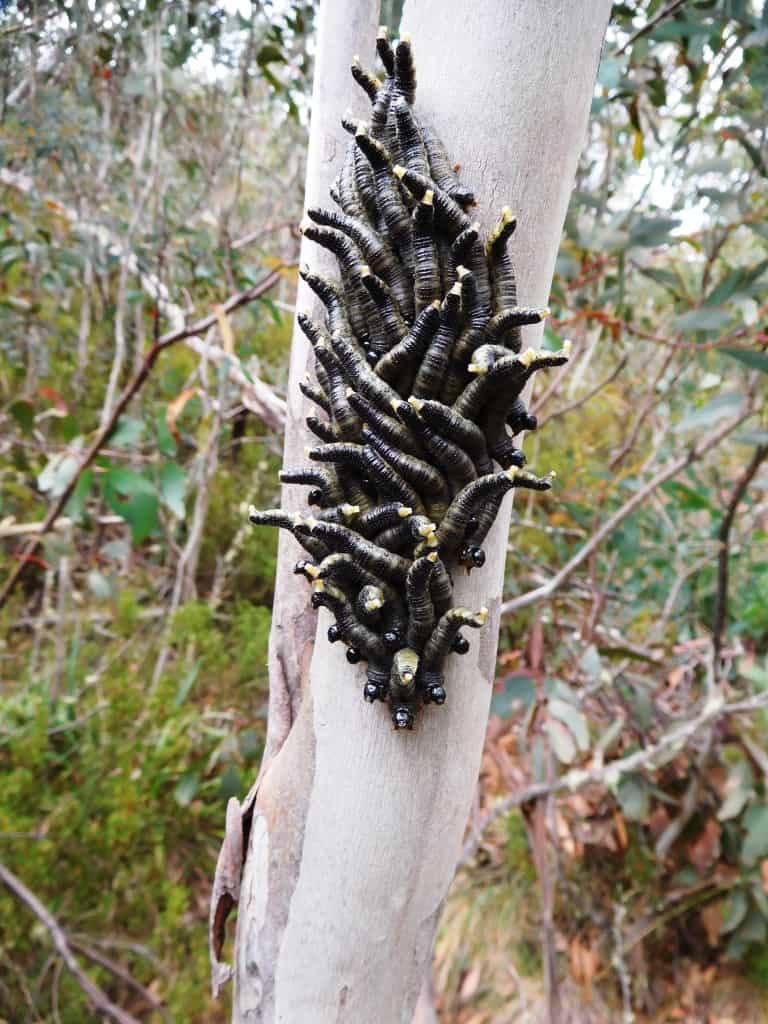
Or this magnificent chap?
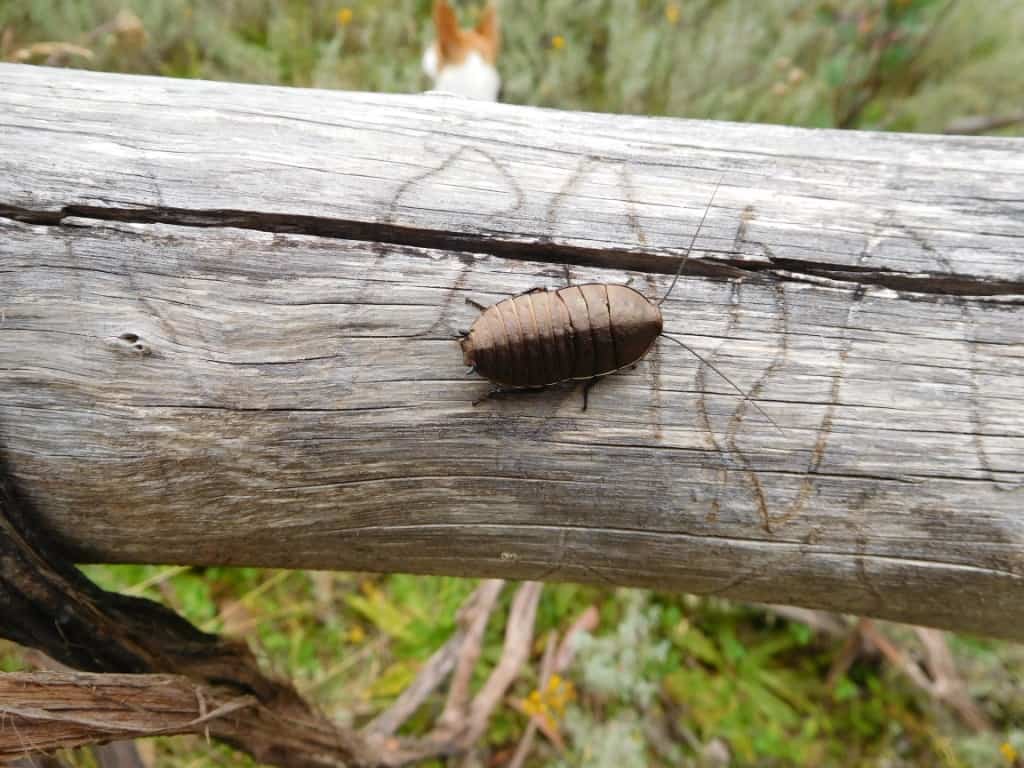
Still, I was glad to get back to my car.
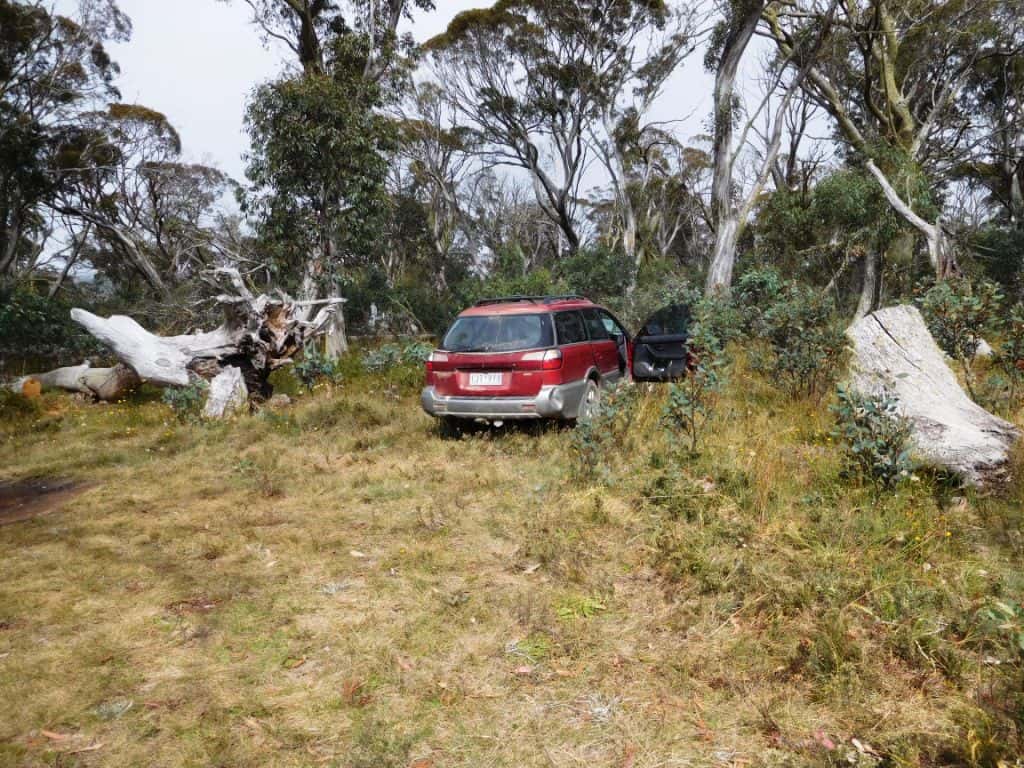
A little battered from some of the thick going I encountered.

You will want to know whether I saw any deer? Quite a few actually including three stags all of which I could have taken except surprisingly they were all in velvet – a rare occurrence as these deer are not usually so seasonal. If you wonder why I have not provided photos of them you have not thought carefully about the presence of two terriers! Tends to hurry things along a bit!
But back to hut building…
The three easiest ways to transport building materials for such a hut are the traditional pack horse which brought the corrugated iron and hardware for many High Plains huts in times gone by, river – it is surprising what load you can tow behind your canoe (though slowly) eg on a couple of tractor inner tubes! Build behind a screen of vegetation and above high water though!
The ubiquitous 10′ x 10′ modular garden shed which goes together in a couple of hours if you have a rechargeable drill is a popular choice and costs from as little as $500, not much if shared amongst say four mates. (Try a search for ‘Garden Sheds Shopping’). Another good point about it is that you can easily pre-paint it before you take it into the bush. You can usually buy green anyway, so it is really only a matter of splotches of some yellows/browns etc to break up the pattern. A few spray cans might be just as easy.
It is surprising how far you and transport such a building (even alone) using just a simple two-wheeled cart constructed from used bicycle parts from the municipal tip. My experience is many miles from any road. The further the better – human vermin are the worst pests to invade a hut!
I think utilising a (possibly electric) mountain bike and a bike trailer (second-hand children’s bike trailers can often be sourced for under $50) along permanently closed/seasonally closed or management vehicle only roads a person alone could transport a pretty handy 2 x 2.5 metre shed to a point where some handy stream intersected such a trail and then via a bit of manhandling in sections a couple of hundred metres into the bush with relative ease. ‘A word to the wise’ as they say.
You can usually construct some foundations to secure it and a lightweight concrete floor with just 3-4 bags of cement and some sand and gravel from a stream. The easiest way to make a (suspended) concrete floor (this used to be common) is simply to hoe up the soil until it is loose, then ‘float’ a thin concrete floor over the top of the loose dirt. Only half an inch is necessary. I know you won’t believe me.
About every 6″ (or closer) drive a crowbar or like instrument into the ground ( a similar depth)and let the concrete flow down the hole making little ‘pillars’ about an inch in diameter. When finished, trowel the whole thing off. When the concrete has set the soil will settle away from it about an inch creating an insulated air gap underneath the floor! How good is that?
The hut itself can be insulated (eg) with fibreglass bats secured by netting or reflective foil sarking. The space inside can be heated by one of the very small pot-belly stoves which are available usually made from used gas bottles – or make one yourself. Even the helium bottles would last a while and are much lighter.
Even one of my tent stoves would put put enough heat for a small hut using only about 500 grams of twigs an hour to produce around 1000 watts. Make a couple of netting baskets under the sink to contain some . The stove can also provide all your cooking. The advantage of this system is that all the hut build materials are fire-proof. You only need to store a couple of kilos of dry twigs as the heat of the fire will dry out more as you go along. A small wood pile outside can be kept dry with some black polyethylene sheeting.
People usually ‘beef up’ some of the framing (eg of the doorway or to create bunks), if desired. I believe adding a light angle iron frame would substantially improve strength particularly in high wind areas without greatly increasing weight, though I should say that I utilised one of these unmodified sheds as a pump house in a particularly windy area for many years on one of our old farms, and I have owned others
One advantage of a concrete floor is that canoe drums can be incorporated in the floor (eg under the bunks if you decide to have them, in corners, under the sink etc) and covered with ’tiles’ of fibro (to keep the floor flat) into which materials which might be destroyed by rodents (or which are readily flammable) can be safely placed.
It is better to use self-inflating or insulated inflatable mattresses which can be stored in the drum – along with the sleeping bags etc, as vermin are always a problem in back-county huts – and other sorts of mattresses are bulky and particularly subject to a build-up of (cold) moisture and mould.
Of course you don’t actually need bunks, especially if the floor is insulated! Around six people can sleep on the (100 ft 2) floor of such a hut hanging their packs on hooks mounted on the tops of the walls. When everyone is up there is room aplenty. You can even de facto double glaze the window with some clear plastic.
Many people take a second hand stainless steel sink in to provide some plumbing and safe cooking/food preparation. Again you can take one home (including taps, drainage outlets from the tip or the metal recyclers for the price of a six pack. Try to use metal plumbing as the pipes exit the hut (or underground them) so that the pipe does not create a wick for sparks/flame to the inside of the hut.
If the hut is in a small grassy clearing at the bottom of a fairly damp gully (but above flood danger) it is surprising how well a metal hut will stand up to bushfires. The deer/wallabies etc will usually keep the grass short enough in the vicinity of the hut. If it only has to contend with a short grass fire (and has a concrete floor joined to metal walls/roof the flames will usually just extinguish against the base of the walls. Of course if it should be away from trees anyway so that they don’t drop branches on it.
You can lead the water to the hut using eg a 50 metre coil of 3/4″ (19 mm) poly. Just be sure it is buried near the hut. As the sink will be only about 3′ above the ground , you only need a couple of more feet of head than that for the water to flow. The inlet should be in a small (2l?) black plastic drum which you have drilled full of holes so that it does not block up. The pipe can be secured with a judicious placing of small rocks to hold it down without compressing it. Probably a good idea to bury the pipe for its entire length – a couple of inches will do.
Many people add a small solar panel to the roof and a small (eg 9 amp hour) sealed lead acid battery to their hut to provide LED light and charging for cameras, sat phones etc. This is now so inexpensive compared with the amenity gained that it is a no-brainer really.
A 16 db yagi antenna mounted on a pole connected to a passive pads can bring in a very weak mobile signal which might even provide internet service, video messaging, weather info, etc in many places. Two can be coupled to add another 3 db.
If not UHF via a similar antenna should be able to connect you to established repeaters. A decent (9 db?) omni-directional UHF external antenna is a great option anyway to reliably connect to mates who are out in the bush somewhere. A (magnetic) satellite phone antenna on the roof is also an option when you are in camp. It can be good to be in touch with loved ones even in such remote spots.
A dependable folding table takes up less space than a fixed one and can also be more readily taken outside on a sunny day. 3-4 folding chairs/stools for just such occasions are a ‘must’ too. These can also be hung from hooks mounted on the tops of the inner walls when not in use.
These little garden sheds are cheap and light as I’m sure you know if you have ever bought and assembled one. They usually weigh a little over 100 kg (pack only) . When I was younger I could carry one unaided (not maybe for mile on mile – as I am not a sherpa, but you get the point).
Imagine a small group of you decided to build a number of these sheds linked by a secret route. Each would be roughly a comfortable day’s hunting (say 5-6 hours apart and the first and last a similar distance to car access. I’m sure you can think of a suitable loop.
How many could be carried (along with the cement, furniture etc in a single helicopter flight? 5-6 perhaps? Say half a dozen of you decided on such a venture. For each an expenditure of a little more than $1,000 and a few days work would have access to half a dozen wilderness huts encompassing a vast hunting territory! And no-one else need ever know!
NB: Some people add a fold down verandah which when closed completely covers and secures the door and window but when erected gives an eg 10′ x 6′ outdoor verandah which is such a help if there is a crowd. Probably a woven awning of some sort which can be put up or taken down quickly is structurally safer especially in high wind areas. Mind you there are sheltered upland valleys the wind never seems to find.
I will do a post about ‘the ‘perfect wilderness hut’ in the future with some other design ideas. An even smaller hut, possibly 2 x 2.5 metres might shelter 2-4 people adequately. I realise also that internal space can be more useful if the door opens outwards but in such a case a stuck door will make it very difficult to get in which could be a problem!
In the meantime I was very impressed with this one I encountered in the bush (near the Grant Burn – hard to find) on our South Coast Track (Fiordland) walk back in 2016! How time flies when you are having fun. It was so well insulated that body heat alone was sufficient to warm it even down to zero C. You can get an idea of the dimensions from the size of the bunks.
Here it is:
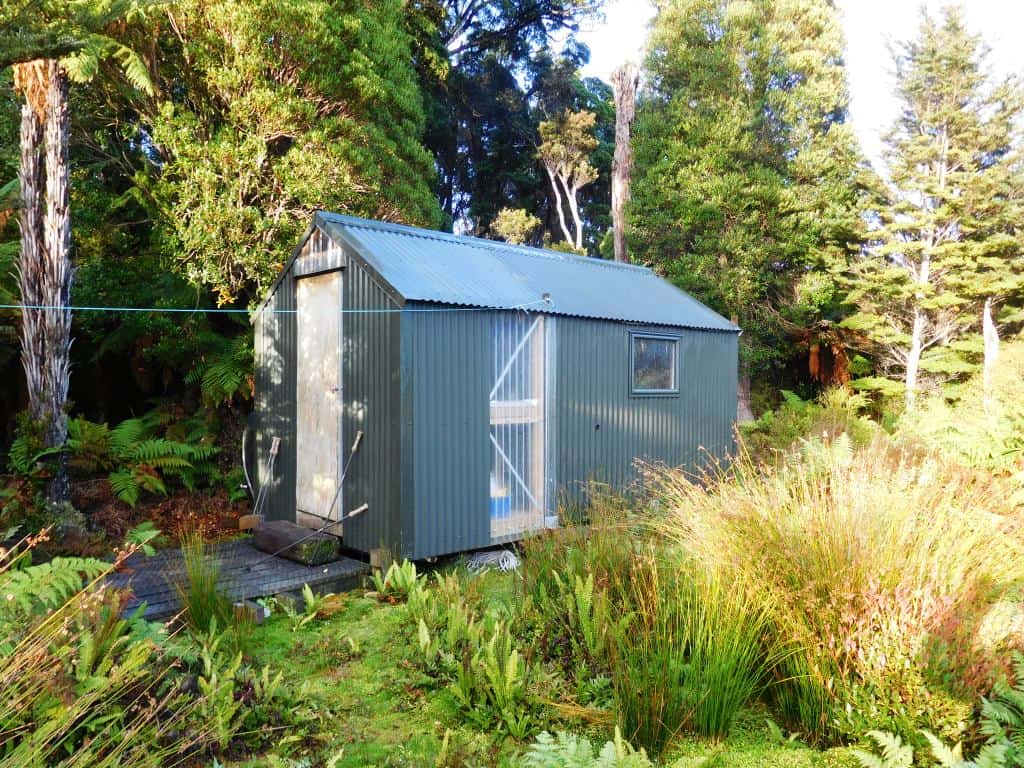
It had a small entry for hanging wet gear.
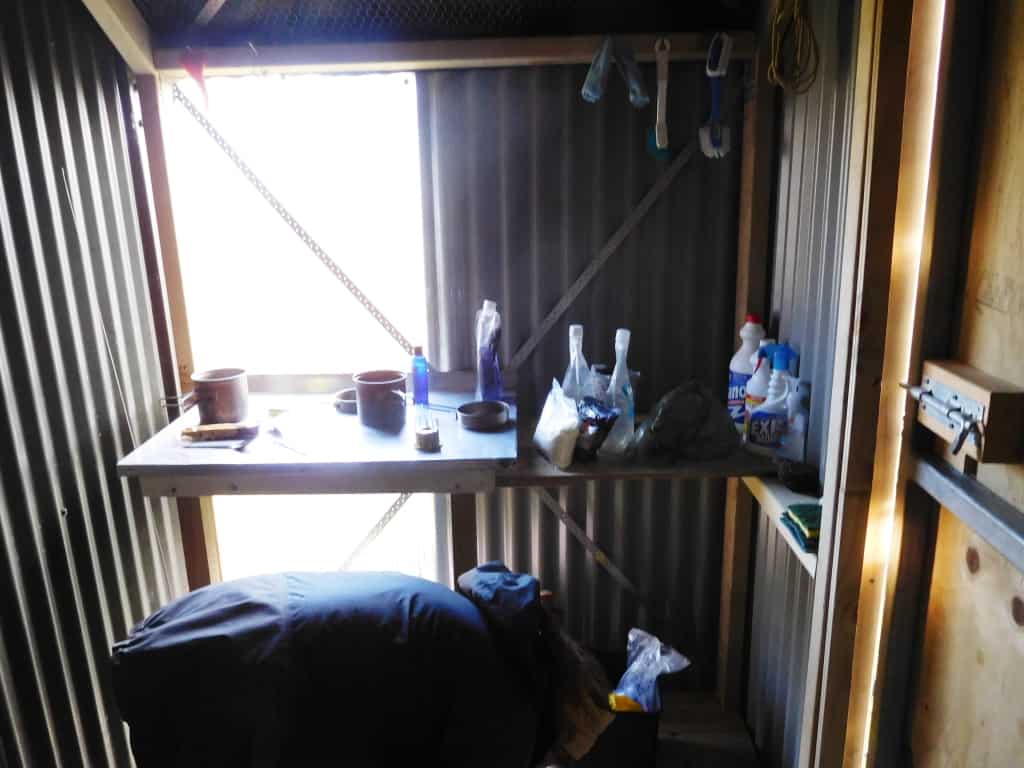
and these lovely two warm bunks.
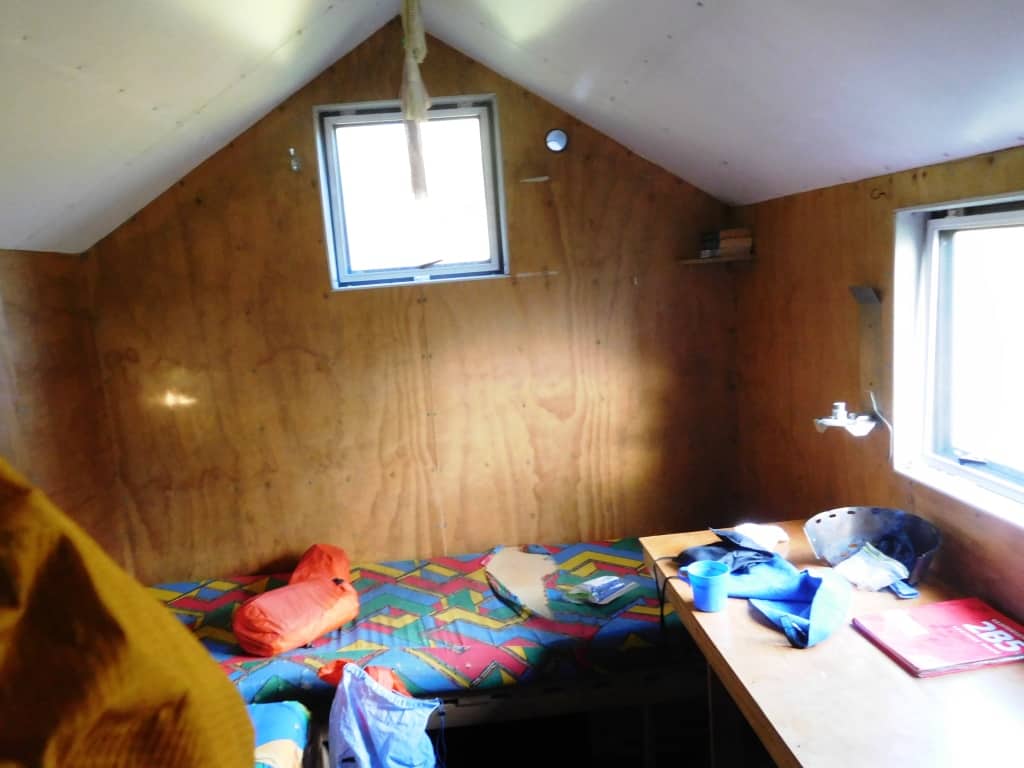
See Also:
